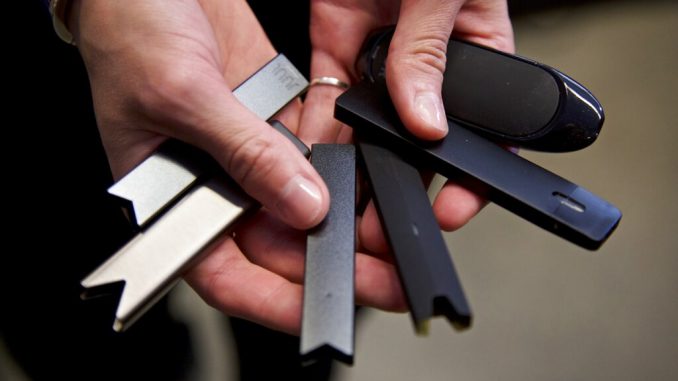
NEW YORK — Vaping by U.S. teenagers fell dramatically this year, especially among middle schoolers, according to a federal report released Wednesday.
Experts think last year’s outbreak of vaping related illnesses and deaths may have scared off some kids, but they believe other factors contributed to the drop, including higher age limits and flavor bans.
In a national survey, just under 20% of high school students and 5% of middle school students said they were recent users of electronic cigarettes and other vaping products. That marks a big decline from a similar survey last year that found about 28% of high school students and 11% of middle school students recently vaped.
The survey suggests that the number of school kids who vape fell by 1.8 million in a year, from 5.4 million to 3.6 million, officials said.
But even as teen use declined, the report shows a big bump in use of disposable e-cigarettes. The Food and Drug Administration earlier this year barred flavors from small vaping devices like Juul and others that are mainly used by minors. The policy did not apply to disposable e-cigarettes, which can still contain sweet, candylike flavors.
“As long as any flavored e-cigarettes are left on the market, kids will get their hands on them and we will not solve this crisis,” Matt Myers of the Campaign for Tobacco Free Kids said in a statement.
The national survey is conducted at schools each year by the Centers for Disease Control and Prevention and usually involves about 20,000 middle and high school students. It asks students if they had used any vaping or traditional tobacco products in the previous month. The survey was cut short this year as schools closed because of the coronavirus pandemic.
Federal health officials believe measures like public health media campaigns, price increase and sales restrictions deserve credit for the vaping decline. The age limit for sales in now 21.
But they also acknowledge the outbreak probably played a part. The CDC’s Brian King said sales started falling in August — when national media coverage of the outbreak intensified.
“It’s possible that some of the heightened awareness could have influenced decline in use,” said King.
By year’s end, more than 2,600 illnesses and close to 60 deaths were reported. Most of those who got sick said they vaped solutions containing THC, the ingredient that produces a high in marijuana. CDC officials gradually focused their investigation on black market THC cartridges, and on a chemical compound called vitamin E acetate that had been added to illicit THC vaping liquids.
Kenneth Warner, a professor emeritus at the University of Michigan’s school of public health, said the teen vaping drop was larger than expected.
“This does look like a very substantial decrease in a single year and it’s very encouraging,” said Warner, a tobacco control expert.
Among the likely factors, Warner noted the general negative publicity surrounding vaping. Additionally, Juul preemptively pulled all its vaping flavors except menthol and tobacco last fall ahead of federal action.
Warner and other researchers have tracked a recent decline in teen smoking to all-time lows — about 6% — even as vaping has increased. He said it will be critical to watch whether teen smoking begins rising again as fewer teens vape.

